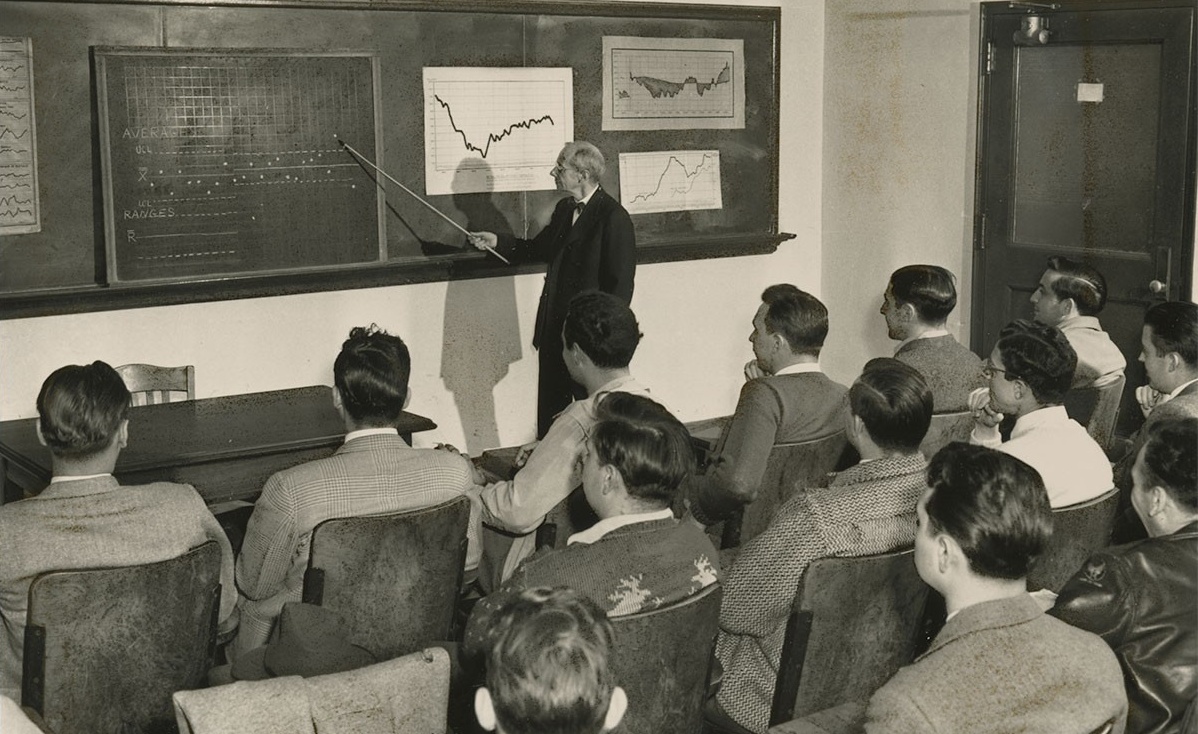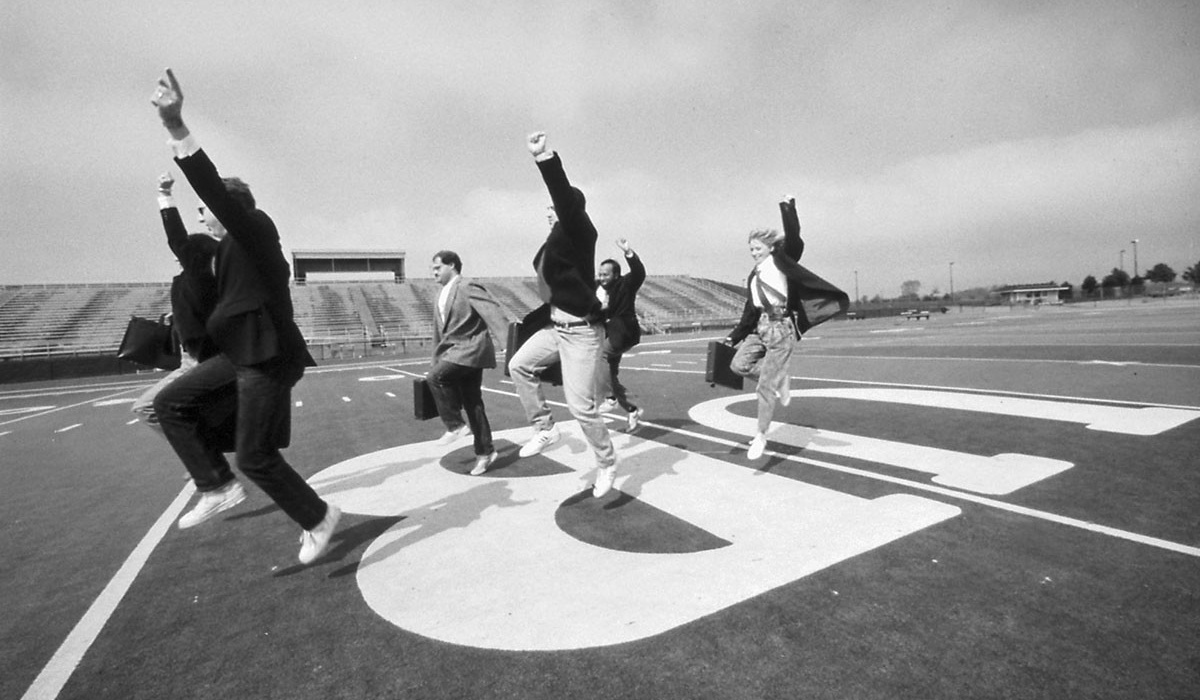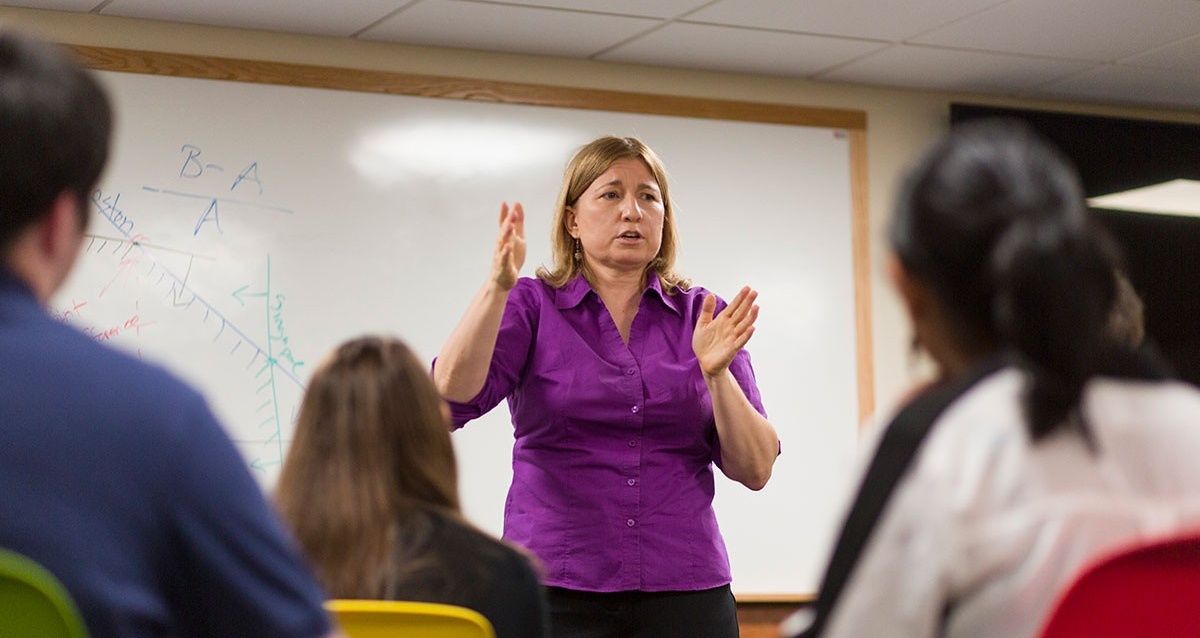Building leaders, changing lives
The School of Management celebrates 100 years
By Jacqueline Ghosen
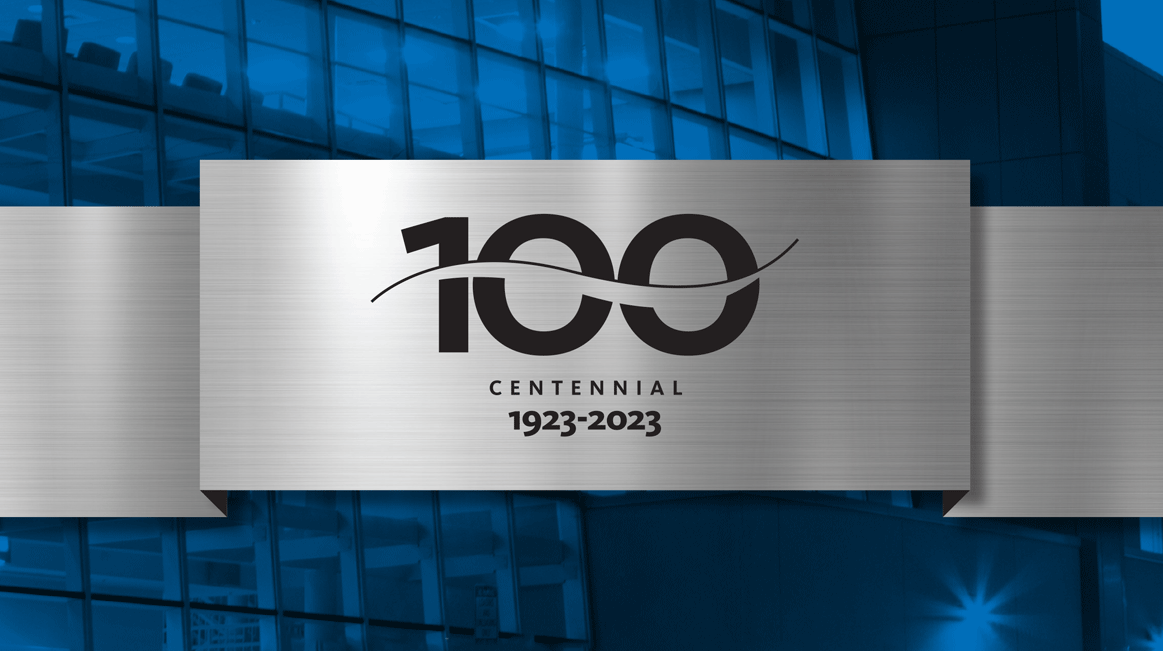
The year was 1923. Calvin Coolidge was sworn in as president of the United States following the sudden death of President Warren Harding.
In medicine, the whooping cough vaccine was developed and, in Hollywood, German shepherd Rin Tin Tin became film’s first canine star. Gasoline was 22 cents a gallon and, thanks to mass production, the price of Ford’s Model T dropped to about $260.
In Buffalo, the UB Council’s committee of general administration established the evening session of Business Administration and Journalism. The first classes were held downtown in Townsend Hall on Niagara Square.
The first Bachelor of Science in business administration was awarded in 1927 and the council authorized a day division of the School of Business Administration as a two-year course of study. Instruction was held in Hayes Hall on the Main Street Campus.
A class in Crosby Hall in the early 1950s. Historical photos: University Archives
Edmund D. McGarry, professor of marketing and economics, recalled those days in a personal reminiscence he wrote in the 1950s.
“When I arrived in 1927, there were six of us on the faculty of the business school. Dean Marsh, Dr. Epstein, Dr. Lockhart, Professor Burton, a man named Born and myself. We had an executive committee, a library committee, a graduate committee and committees ad hoc ad infinitum. But as there were only six of us, we were all on all the committees. When we changed from one committee to another, we just changed seats. We had unbound enthusiasm, for we knew we were building a new school.”
The school was accredited in 1930 by the American Association of Collegiate Schools of Business, which later became AACSB International.
The following year, the school initiated a part-time MBA program and the first MBA degree was awarded to Harold A. Baker in 1933.
Construction of Crosby Hall was completed in 1932, and the building became the first permanent home of the school. The UB Council named it in honor of the contributions of William H. Crosby, a bicycle frame manufacturer who served on the UB Council and as university treasurer and chair of the finance committee.
AACSB held its annual meeting in Buffalo that spring in conjunction with the dedication of Crosby Hall, and Dean Marsh was elected president of the association. At the same time, scholastic honor society Beta Gamma Sigma installed a chapter at the school. McGarry’s memoir reflects the times: “During that year, we were riding high, wide and handsome,” he wrote. “That is, until fall of that year when something hit us.”
Leaner times
“Up until that time, the Depression was largely a matter of mere academic interest, to be discussed in Professor Tippett’s business cycle course,” McGarry wrote. “In general, college teaching was regarded as a sheltered occupation. Although it was before the days of Keynes’ General Theory, we believed in deficit financing. Then suddenly, one afternoon, the heads of departments were called together and told that there was not enough money to go around; the banks refused to lend us more. There was no alternative but to accept a salary cut. Thus we learned the word ‘retrenchment’ the hard way.”
Enrollment stabilized between 1932 and 1942, never falling below 200 and never rising above 300. “Those were lean years for the university, and at times we hardly knew whether it could be held together,” McGarry wrote.
In 1942, enrollment began to drop further and by the following year, selective service had reduced the student body to a mere handful. An Engineering, Science and Defense Training (ESDT) program was established.
In those days, according to McGarry, “We attempted to serve our country by giving pre-flight training to would-be officers of the air corps. The faculty had to bend its teaching of economics, labor and marketing to the Army’s demand for strategy, tactics and logistics. Dean Somers taught physics. My own experience in handling horses in the field artillery in the first World War was a little old fashioned for the Air Force, so I was assigned to teach, of all things, celestial navigation.”
The turning tide
When the hosts of GIs began to return from war in 1945, the school faced different challenges. “In 1946, we had 1,364 students, six times as many as we had in 1942. The big problem was where to find teachers and where to find a place to put the students,” McGarry recalled. “When the GIs left, we eventually dropped back to about 500, about double our pre-war enrollment.”
In 1949, the school honored Melvin H. Baker, president and founder of National Gypsum, with the inaugural Executive of the Year award, an annual tradition that continues to this day.
The school also established a doctoral program with a specialization in business that year and admitted its first two doctoral candidates in 1950. C. Perry Bliss, professor emeritus of marketing, received the school’s first PhD degree in 1953.
Other indicators of the school’s growth were the 1955 endowment of the Melvin H. Baker Professorship in American Enterprise and the 1956 endowment of the M&T Professorship in Finance.
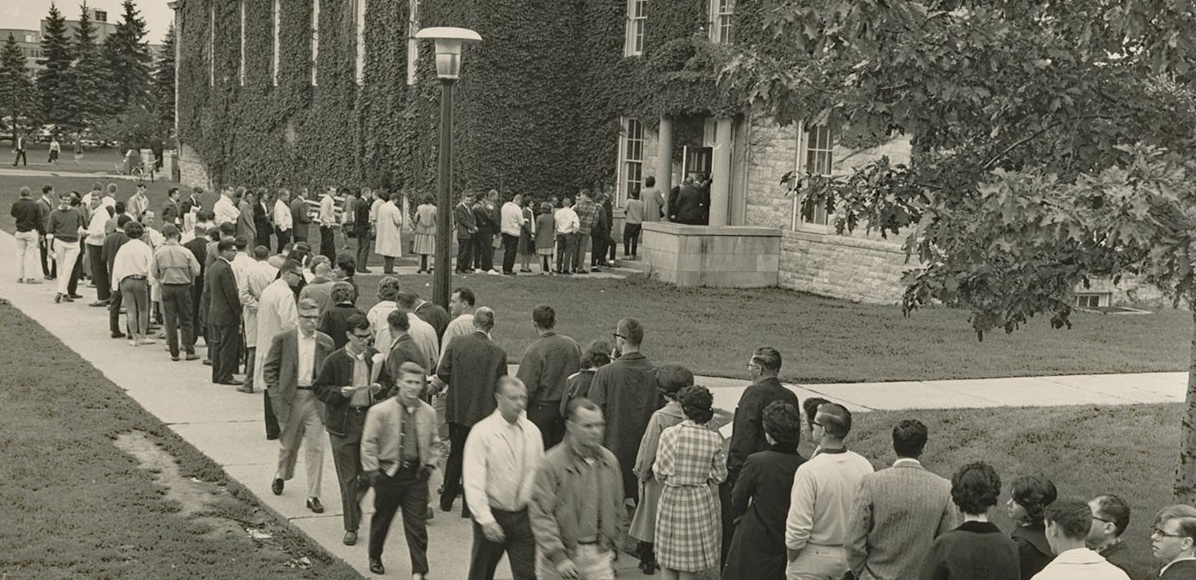
Students line up to register for classes outside Clark Hall in 1963.
Times they are a-changin’
The 1960s brought more change to the school and the university. In 1962, the University of Buffalo became the State University of New York at Buffalo, when UB was incorporated into the State University of New York (SUNY) system. The acquisition was championed by then-governor Nelson Rockefeller, with the intent of making UB one of four major university centers in the state. UB has since earned recognition as SUNY's flagship university.
A full-time MBA program was initiated in 1963 and, on January 1, 1969, the School of Business Administration was officially renamed the School of Management. Richard Brandenburg, who served as dean from 1968 to 1976, explained the name change in a letter to alumni: “It has become increasingly clear that management concepts and tools first used in the business context also are useful in understanding and managing other types of organizations. The growing importance that public service agencies, health centers, government departments and educational institutions play in ensuring the desired quality of society has led to great demands and opportunities for diversified faculty teaching, research and consulting,” he wrote, noting that changing the school’s name was a logical step “to give formal recognition to these broader interests and responsibilities.”
The school established an internship program in 1971 that allowed students to earn academic credit while undergoing onsite training at area firms and agencies. The program went on to become one of the largest in the country.
In 1977, under Dean Joseph Alutto, the school launched a Center for Management Development to initiate and coordinate continuing education programs for practicing managers. He also established a Corporate Advisory Board in 1978.
The big ’80s
Members of the 1990 School of Management Precision Briefcase Drill Team practice their routine for the Buffalo St. Patrick’s Day parade.
The next decade was a time of considerable growth and expansion for the School of Management. A major grant in 1982 from the Jacobs family brought endowed chairs in finance and human resource management.
And, as the school evolved, its sphere of influence widened far beyond the local community. In 1984, the school established the first U.S. MBA program in China, with support from the Chinese Ministry of Education and the U.S. Department of Commerce. President Ronald Reagan announced the creation of the program during a diplomatic trip to China that year; news of the announcement made headlines all over the world. Henry Kissinger gave the keynote address to the first graduating class in 1986 at the ceremonies held in Buffalo. Headquartered at the Dalian University of Technology, the program graduated more than 200 students before being phased out in the aftermath of the Tiananmen Square protests in 1989. The last Dalian class graduated in 1991.
Thanks to a $1 million gift, the Jacobs Management Center on UB’s North Campus in Amherst was officially opened in 1985 and replaced Crosby Hall on the South Campus as the School of Management’s home. The building honors the late Louis Jacobs and his wife, the late Genevieve Bibby Jacobs, and their three sons, Jeremy M. Jacobs, the late Lawrence D. Jacobs and Max Jacobs.
In an innovative approach to serving the needs of the business community, the school established the Center for Entrepreneurial Leadership in 1987 and has been assisting area entrepreneurs ever since.
Approaching the millennium
The school’s global reputation was burgeoning, and the early ’90s were marked by the creation of several international partnerships. With funding from a series of federal grants, the school provided instructional and consulting services in Hungary. The school also partnered with UB’s English Language Institute and the University of Ottawa in 1994 to help establish a new business school at the Riga Technical University in Latvia. The Riga Business School awarded the first MBA degrees the next year.
Frederick “Rick” Winter was named dean in 1994, succeeding Howard Foster, who served the school from 1990 to 1994 in what was by all accounts the longest interim dean appointment in the school’s history. That same year, the school introduced the Executive MBA program, and the first class of 21 students graduated in 1996.
In another global collaboration, the school reached an agreement with the Singapore Institute of Management to offer an Executive MBA in Singapore that began in 1996.
Dean Winter identified five “megatrends” that were shaping business education: globalization; the need for skills beyond classroom experience; increased competition; strategic alliances; and declining state and federal support.
Winter reconstituted the school's Corporate Advisory Board to include distinguished alumni as well as local executives, and renamed it the Dean’s Advisory Council.
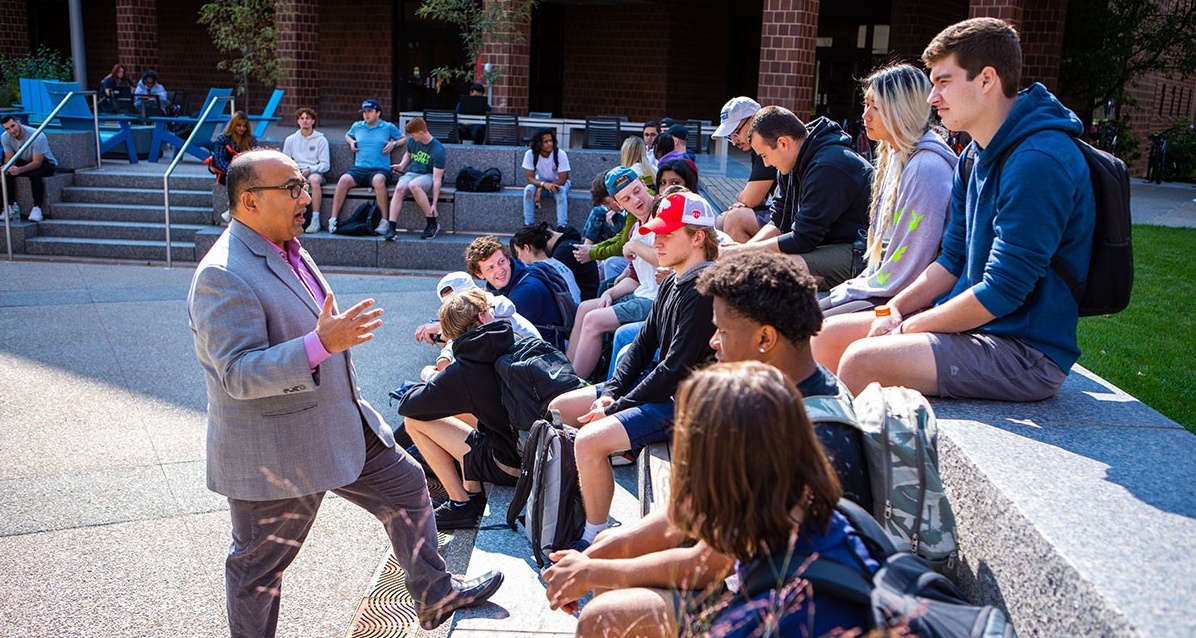
Prasad Balkundi, associate professor of organization and human resources, teaches a class in Paula’s Plaza.
In 1997, the school’s part-time MBA program was transformed into the Professional MBA program, creating a more convenient and streamlined evening program for working professionals.
With the 1998 launch of the first-ever Executive MBA program in China, the school made a historic return to the country where it forged its reputation as a leader in international management education. Offered at Renmin University of China in Beijing, the new program was created to provide top executives with an education in Western-style management practices.
“Our first class is representative of the complex, changing economic climate of China,” said Lewis Mandell, who had taken the helm as dean that year. “We have a mix of executives from U.S. corporations, European corporations and Chinese state-owned enterprises. For business to compete in the world marketplace, it is imperative that the country’s top executives learn new ways of thinking and working.”
The school was praised by BusinessWeek as “a pioneer in the Asian market for management education.”
Back on American soil, the school launched an innovative new competency-building course for its MBAs called Leadership PACE (Personal Achievement through Competency Evaluation). The course was created to help MBA students develop the intangible skills that make the difference between being a good executive and a great one.
“We went directly to corporate recruiters and asked what traits they most desire in their employees,” explained Jerry Newman, SUNY Distinguished Teaching Professor Emeritus and champion of the program. “Then we created a program designed to develop exactly those skills in our MBAs.”
With Dean John M. Thomas at the helm from 2002 to 2008, the school developed new curricular initiatives in technology entrepreneurship and global services and supply management, as well as a new Master of Science in Management of Information Technology Services in India, in collaboration with Amrita University and Hewlett Packard. Thomas has been credited with making UB a leader in international management education.
Construction of the three-story, 23,000-square-foot Alfiero Center was completed in 2005. An architectural masterpiece of glass, brick, space and light, the center is entirely student-focused and is now the hub of student life in the school. Alfiero Center houses academic advising and career development offices that assist more than 3,000 management students each year. It features three high-tech lecture halls, a café, a suite of offices for student organizations and multiple team breakout rooms.
The Alfiero Center was the first academic facility at UB, and one of only a few in the SUNY system, to be funded primarily through private donations. Gifts from more than 150 alumni, friends, foundations and corporations provided the majority of the funding for the $7 million center. The center itself is named for the chair and CEO of Protective Industries, Sal H. Alfiero, and his wife, Jeanne, who made a $2 million gift to the school.
A curriculum for a new era
Arjang Assad became dean in 2008 when Thomas elected to return to his faculty role. During his tenure, Assad led a comprehensive revision of the MBA curriculum, launched a Master of Science in Accounting and significantly enhanced the Master of Science program in Finance. He also led the school through several strategic areas of focus — leadership, entrepreneurship and health care management.
In 2010, the school launched LeaderCORE™, a comprehensive leadership certification program that spans the entire two years of the full-time MBA program. Like its forerunner, Leadership PACE, the program focuses on helping students develop the core competencies considered vital by the business community for effective performance and successful leadership. LeaderCORE won the MBA Roundtable Innovator Award and is now available as a micro-credential.
In other innovations, the Terese Kelly Investment Group was created in 2011. The student-run, real-money investment fund educates finance students on the practical aspects of global capital markets, while providing them with real-world learning experiences in investment management.
Natalie Simpson, associate dean for graduate programs, and professor and chair of operations management and strategy, teaches in the Leadership Learning and Community Center.
Moving forward
Throughout the 2010s, the School of Management made a strategic commitment to health care delivery systems by continuing joint degree programs (MD/MBA, DDS/MBA and others), as well as developing an instructional program in health care management and a new MBA health care concentration.
The Center for Leadership and Organizational Effectiveness opened in 2013. Championed by Paul Tesluk, the school’s Carmichael Professor of Organizational Behavior, the center advances research, education and outreach in leadership and organizational development.
When Assad left UB in 2015, Tesluk became dean after a stint as interim. He led a comprehensive strategic planning effort that resulted in a revised mission and vision, as well as a focus on leadership, entrepreneurship, health care management, social innovation and global programs, as well as an increased commitment to diversity and inclusion.
That same year, the school opened its Leadership, Learning and Community Center. Funded with a lead gift from Frank, BS ’66, and Marilyn Clement, the center includes three classrooms, a community area, tutoring facilities and a group study area where students develop skills for lifelong success.
The school developed educational programs to help meet the growing demand for highly skilled workers in the high-tech workforce. Examples include a BS in Information Technology and Management, an MS in Business Analytics, and a robust and rapidly expanding set of micro-credentials and non-degree programs. In addition, the on-campus Professional MBA program was successfully converted to a hybrid format.
Global experiential learning grew significantly during this era as well. New programs enabled students to immerse themselves in another culture and make an impact, preparing them to lead in today’s business world.
No retrospective of the school would be complete without mention of the crisis that upended the world. The COVID-19 pandemic brought unprecedented challenges and, for some, tragic loss, but members of the UB and School of Management communities came together as one, offering support to each other. The short video below highlights how students, alumni, faculty and staff demonstrated their remarkable resilience as they adapted, pivoted and ultimately thrived.
Samantha Moser, BS ’21, completed a virtual internship for Comcast during the COVID-19 pandemic and went on to become an analyst for the company after graduation.
Crisis, pivot, thrive
In March 2020, operations came to a screeching halt as students, faculty and staff were sent home to finish the semester remotely while the school, the nation and the world grappled with the COVID-19 pandemic. It was a period of uncertainty, fear and, for some, tragic loss. Yet despite the adversity, faculty and staff doubled down to ensure that students still received the outstanding educational experience they deserved. Similarly, students pivoted and quickly adapted to new ways of learning; employers collaborated with career staff to create virtual internships; and alumni reached out to see how they could help.
“We are stronger together,” said Dean Tesluk. “The resilience and character of our entire university community will enable us to innovate and even excel as we continue our mission in new and interesting ways.”
In 2022, Ananth Iyer, an accomplished scholar in operations and supply chain management from Purdue’s Krannert School of Business, was named dean after Tesluk left for a provost position at Bentley University. In one short year, Iyer collaborated with faculty and alumni to establish several key initiatives (see Insights, page 26) for the school, including the business of climate change; business analytics; the social impact of management; and innovation, entrepreneurship and leadership.
Under his leadership, the school has launched an Online MBA, an Online MS in Business Analytics and a STEM pathway in the full-time MBA program. In 2024, the school will introduce an MS in Management for nonbusiness majors, and more programs are under development.
The school hosted a ribbon cutting and dedication in fall 2022 for Paula T. Agrusa Plaza, which features totally refreshed exterior spaces on both sides of Jacobs Management Center. Made possible by a gift from alumnus Russ Agrusa, BS ’76, in memory of his wife and School of Management alumna, Paula Agrusa, BS ’78, the space includes a pocket park filled with flowers, benches, walking paths, a firepit and café-style lighting. The plaza creates a welcoming entrance and provides outdoor learning environments and spaces for faculty, students, alumni and visitors to gather and collaborate.

An additional sign of progress is the school’s considerable investment in entrepreneurship. While widening the scope and reach of its Center for Entrepreneurial Leadership, the school is also partnering across UB to foster a thriving entrepreneurship ecosystem for students. A minor in entrepreneurship, an entrepreneurship concentration and collaboration with UB’s Blackstone LaunchPad have all contributed to the university’s recent ranking by the Princeton Review and Entrepreneur magazine as one of the country’s top schools for entrepreneurship. And the Panasci Technology Entrepreneurship Competition, which awards seed money and business services to the teams that present the best plan for the launch of a viable new business in Western New York, is now in its 23rd year
“With UB’s designation as SUNY’s flagship campus and our ambition to become a top-25 research university, the school is keenly focused on the markers critical to those ambitions: disciplinary excellence, research funding, diversity of our faculty and student body, and overall impact,” says Iyer. “As we continue to expand our horizons within the global marketplace, you can be sure that a degree from the UB School of Management is a credential that unlocks opportunities around the world.”
